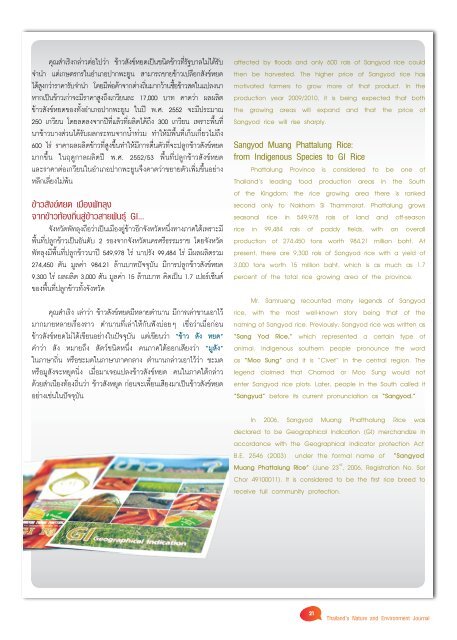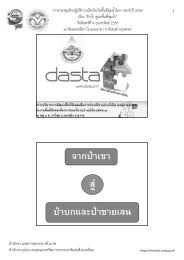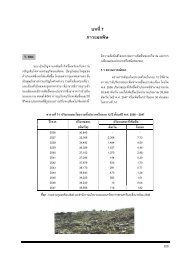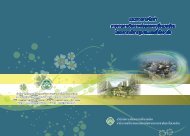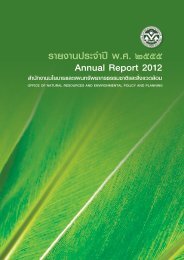ปีที่ 5 ฉบับที่ 3 กรกฎาคม-กันยายน 2552 - สำนักงานนโยบายและแผน ...
ปีที่ 5 ฉบับที่ 3 กรกฎาคม-กันยายน 2552 - สำนักงานนโยบายและแผน ...
ปีที่ 5 ฉบับที่ 3 กรกฎาคม-กันยายน 2552 - สำนักงานนโยบายและแผน ...
You also want an ePaper? Increase the reach of your titles
YUMPU automatically turns print PDFs into web optimized ePapers that Google loves.
คุณสําเริงกล่าวต่อไปว่า ข้าวสังข์หยดเป็นชนิดข้าวที่รัฐบาลไม่ได้รับ<br />
จํานํา แต่เกษตรกรในอําเภอปากพะยูน สามารถขายข้าวเปลือกสังข์หยด<br />
ได้สูงกว่าราคารับจํานํา โดยมีพ่อค้าจากต่างถิ ่นมากว้านซื ้อข้าวสดในแปลงนา<br />
หากเป็นข้าวเก่าจะมีราคาสูงถึงเกวียนละ 17,000 บาท คาดว่า ผลผลิต<br />
ข้าวสังข์หยดของทั้งอําเภอปากพะยูน ในปี พ.ศ. <strong>2552</strong> จะมีประมาณ<br />
250 เกวียน โดยลดลงจาก<strong>ปีที่</strong>แล้วที่ผลิตได้ถึง 300 เกวียน เพราะพื้นที่<br />
นาข้าวบางส่วนได้รับผลกระทบจากน้ําท่วม ทําให้มีพื้นที่เก็บเกี่ยวไม่ถึง<br />
600 ไร่ ราคาผลผลิตข้าวที่สูงขึ้นทําให้มีการตื่นตัวที่จะปลูกข้าวสังข์หยด<br />
มากขึ้น ในฤดูกาลผลิตปี พ.ศ. <strong>2552</strong>/53 พื้นที่ปลูกข้าวสังข์หยด<br />
และราคาต่อเกวียนในอําเภอปากพะยูนจึงคาดว่าขยายตัวเพิ่มขึ้นอย่าง<br />
หลีกเลี่ยงไม่พ้น<br />
ข้าวสังข์หยด เมืองพัทลุง<br />
จากข้าวท้องถิ่นสู่ข้าวสายพันธุ์ GI...<br />
จังหวัดพัทลุงถือว่าเป็นเมืองอู่ข้าวอีกจังหวัดหนึ่งทางภาคใต้เพราะมี<br />
พื้นที่ปลูกข้าวเป็นอันดับ 2 รองจากจังหวัดนครศรีธรรมราช โดยจังหวัด<br />
พัทลุงมีพื้นที่ปลูกข้าวนาปี 549,978 ไร่ นาปรัง 99,484 ไร่ มีผลผลิตรวม<br />
274,450 ตัน มูลค่า 984.21 ล้านบาทปัจจุบัน มีการปลูกข้าวสังข์หยด<br />
9,300 ไร่ ผลผลิต 3,000 ตัน มูลค่า 15 ล้านบาท คิดเป็น 1.7 เปอร์เซ็นต์<br />
ของพื้นที่ปลูกข้าวทั้งจังหวัด<br />
คุณสําเริง เล่าว่า ข้าวสังข์หยดมีหลายตํานาน มีการเล่าขานเอาไว้<br />
มากมายหลายเรื่องราว ตํานานที่เล่าให้กันฟังบ่อยๆ เชื่อว่าเมื่อก่อน<br />
ข้าวสังข์หยดไม่ได้เขียนอย่างในปัจจุบัน แต่เขียนว่า “ข้าว สัง หยด”<br />
คําว่า สัง หมายถึง สัตว์ชนิดหนึ่ง คนภาคใต้ออกเสียงว่า “มูสัง”<br />
ในภาษาถิ่น หรือชะมดในภาษาภาคกลาง ตํานานกล่าวเอาไว้ว่า ชะมด<br />
หรือมูสังจะหยุดนิ่ง เมื่อมาเจอแปลงข้าวสังข์หยด คนในภาคใต้กล่าว<br />
ด้วยสําเนียงท้องถิ่นว่า ข้าวสังหยุด ก่อนจะเพี้ยนเสียงมาเป็นข้าวสังข์หยด<br />
อย่างเช่นในปัจจุบัน<br />
affected by floods and only 600 rais of Sangyod rice could<br />
then be harvested. The higher price of Sangyod rice has<br />
motivated farmers to grow more of that product. In the<br />
production year 2009/2010, it is being expected that both<br />
the growing areas will expand and that the price of<br />
Sangyod rice will rise sharply.<br />
Sangyod Muang Phattalung Rice:<br />
from Indigenous Species to GI Rice<br />
Phattalung Province is considered to be one of<br />
Thailand’s leading food production areas in the South<br />
of the Kingdom; the rice growing area there is ranked<br />
second only to Nakhorn Si Thammarat. Phattalung grows<br />
seasonal rice in 549,978 rais of land and off-season<br />
rice in 99,484 rais of paddy fields, with an overall<br />
production of 274,450 tons worth 984.21 million baht. At<br />
present, there are 9,300 rais of Sangyod rice with a yield of<br />
3,000 tons worth 15 million baht, which is as much as 1.7<br />
percent of the total rice growing area of the province.<br />
Mr. Samrueng recounted many legends of Sangyod<br />
rice, with the most well-known story being that of the<br />
naming of Sangyod rice. Previously, Sangyod rice was written as<br />
“Sang Yod Rice,” which represented a certain type of<br />
animal. Indigenous southern people pronounce the word<br />
as “Moo Sung” and it is “Civet” in the central region. The<br />
legend claimed that Chamod or Moo Sung would not<br />
enter Sangyod rice plots. Later, people in the South called it<br />
“Sangyud” before its current pronunciation as “Sangyod.”<br />
In 2006, Sangyod Muang Phatthalung Rice was<br />
declared to be Geographical Indication (GI) merchandize in<br />
accordance with the Geographical indicator protection Act<br />
B.E. 2546 (2003) under the formal name of “Sangyod<br />
Muang Phattalung Rice” (June 23 rd , 2006, Registration No. Sor<br />
Chor 49100011). It is considered to be the first rice breed to<br />
receive full community protection.<br />
21<br />
Thailand’s Nature and Environment Journal


